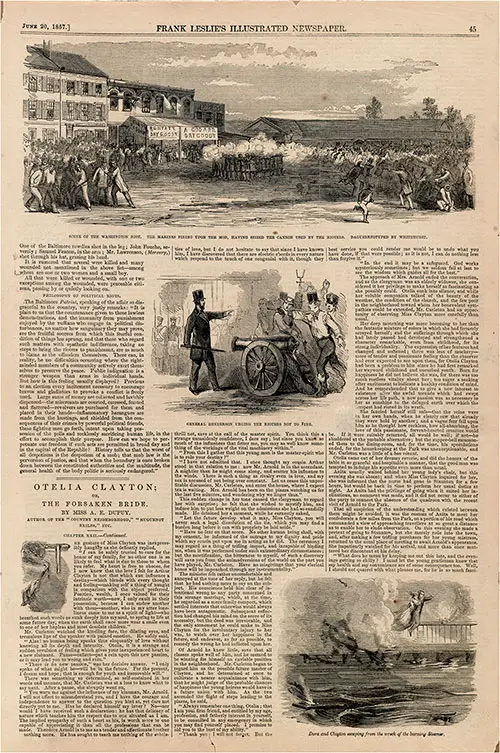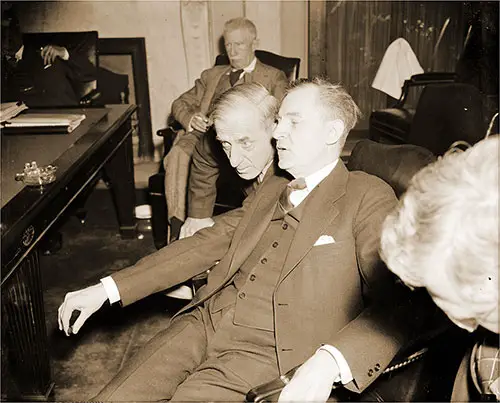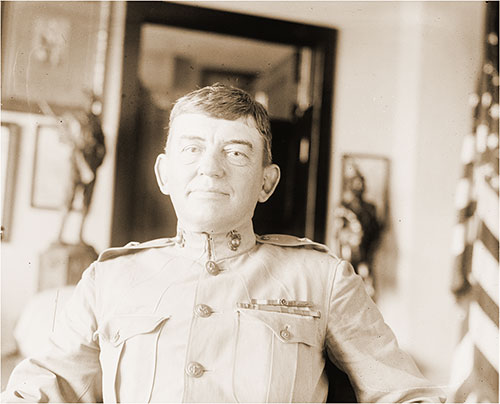Noteworthy Marines in Marine Corps History
Presley Newville O'Bannon, Archibald Henderson, John H. Quick, Daniel Daly, John A. LeJeune, Lewis B. "Chesty" Puller, John L. Foss, John Basilone, Gregory R. "Pappy" Boyington, Ira H. Hayes, Opha Mae Johnson, Annie L. Grimes, Margert A. Brewer, and Molly Marine.
PRESLEY NEVILLE O'BANNON.
First Lieutenant O'Bannon is remembered for heroism in the battle for the harbor fortress of Derna (Trioli) in the Mediterranean. O'Bannon's Marines were the first U. S. forces to hoist the flag over territory in the Old World. The "Mamaluke" sword, carried by Marine Officers today, was presented to O'Bannon in 1805.

Scene of the Washington Riots. the Marines Firing Upon the Mob, Having Seized the Cannon Used by the Rioters. General Henderson Urging the Rioters Not to Fire; Dora and Clayton Escaping From the Wreck of the Burning Steamer. Top Illustration Shows Scene From Riot in Which Members of the Native American, or Know-Nothing, Party Rioted to Prevent Immigrants From Voting; Engraving After Daguerreotype by Whitehurst. Center Illustration Shows Brigadier General Archibald Henderson Intervening to Stop the Riot. Bottom Illustration Shows Scene From Story by Miss a. E. Dupuy, Entitled Otelia Clayton; or the Forsaken Bride. Frank Leslie’s Illustrated Newspaper, V. IV, No. 81 (1857 June 20), P. 45. Library of Congress # 2018650488. | GGA Image ID # 19a58db626
ARCHIBALD HENDERSON
Brevet Brigadier General Archibald Henderson became Commandant in 1820 and held his command for 39 years until his death in 1859. General Henderson led the Corps through the Indian Wars, the War with Mexico, the opening of China, and the disorders in Central America. The "Grand Old Man of the Marine Corps," as he was often called, introduced higher standards of personal appearance, training, discipline, and strived to have the Marine Corps known as a professional military force, capable of more than just sea and guard duties.
JOHN H. QUICK
Sergeant Major Quick is remembered for his performance at Cuzco Well (Guantanamo Bay, Cuba) where he participated in an operation to seize an advanced base for the Atlantic Fleet battalion of Marines. The Sergeant Major won the Medal of Honor for semaphoring for an emergency lift of the naval bombardment while under Spanish and American Shellfire. The landing at Guantanamo demonstrated the usefulness of Marines as assault troops. When employed with the fleet, Marines gave added strength for the capture and defense of advanced bases, becoming a primary mission of the Marine Corps (1898).
DANIEL DALY
Sergeant Major Daly is recognized for earning two Medals of Honor: (1) Chinese Boxer Rebellion and (2) First Caco war in Haiti. When his unit had been pinned down and their attack was stalled during the Battle of Belleau Wood, Then Gunnery Sergeant Daly yelled to his men, " Come on, you sons of a b----, do you want to live forever?

Off-The-Record Answers, Washington, DC, 8 April 1938. Maj. Gen. Smedley D. Butler, One-Time Commander of the U.S. Marines, Gives a Few Off-The-Record Answers to Senator Homer T. Bone (Right), Member of the Senate Naval Affairs Committee, Before Which Butler Appeared Today to Oppose the $1,121,000,000 Naval Expansion Bill. Butler Declared the People Will “Turn On the Bill,” and in All Probability the Proposed New Navy Will Never Be Built, 4/8/38. Harris & Ewing, Photographer. Library of Congress # 2016873376. | GGA Image ID # 19a5391ea6
SMEDLEY D. BUTLER.
Major Butler is recognized for earning two Medals of Honor: (1) Veracruz and (2) First Caco War in Haiti. By the end of 1916, the Marine Corps was recognized as a national force in readiness and for leadership gained from continual combat and expeditionary experience.

Maj. Gen. John A. Lejeune. Overseas Hero Assumes Command of US Marine Corps. Major General John a. Lejeune Today Assumed the Duties of Commandant. National Photo Company. Library of Congress # 2016828304. | GGA Image ID # 19a4c9150f
JOHN A. LEJEUNE
Major General Lejeune served as 13th Commandant of the Marine Corps, 1920-1929. Lejeune was the first Marine officer to command an army division in combat during World War I (1918).
LEWIS B. ("CHESTY") PULLER
Lieutenant General Puller served in Nicaragua through several periods of political unrest and rebellious activity. Puller and a force of about 32 Marines became famous for their ability to engage rebel groups and bandits while scouring the jungles in a wide area of Nicaragua to the Honduran border. Puller became know as the "Tiger of the Mountains" (1930). The Marine Corps mascot, and English bulldog named "Chesty," is named for this brave and fine Marine Corps officer.
JOHN L. FOSS
Captain Foss was a Marine pilot instrumental in taking the Japanese airfield at Guadalcanal. For his participation, he was awarded the Medal of Honor. By the end of World War II, Foss was the secondranking Marine ace, with 26 victories ("kills") to his credit.
JOHN BASILONE
For more than 60 years Marines have heard about the legendary acts of Gunnery Sgt. John "Manila" Basilone. In the steaming jungles of Guadalcanal, two sections of heavy .30-caliber machine guns at the Tenaru River were in charge of defending a narrow pass to Henderson Airfield in the Solomon Islands. Suddenly, Japanese forces attacked their position. Vastly out numbered, the Marines held their ground and fought valiantly to check the savage and determined assault. Suddenly one of the gun crews was knocked out. Disregarding his own life, a Marine lifted his 90 pounds of weaponry and raced 200 yards to the silenced gun pit and started firing. Enemy soldiers attacked to his rear. He cut them down with his Colt .45 pistol. Short of shells, he dashed 200 yards amid a stream of bullets to an ammunition dump and returned with an armload of ammo for his gunners. This Marine battled his way through hostile lines running back and forth between gun pits clearing jams and re-supplying the other Marines with ammo. Flares lit up more swarms of grenade-tossing attackers. The Marines' hands started blistering from the heat of his machine gun, but still he kept shooting. At dawn, reinforcements found this Marine resting his head at the edge of his pit. The line had held. Nearly 100 sprawled enemy dead were around his cut-off outpost. At least 38 enemy dead were credited to this Marine, many killed at arms length. The day was Oct. 24, 1942 and his name was Gunnery Sgt. Basilone. For his actions he was awarded the Congressional Medal of Honor. Gunnery Sgt. Basilone, the man whom Gen. Douglas MacArthur called "a one-man army," became the only man in the history of the United States awarded the Congressional Medal of Honor, the Navy Cross, and the Purple Heart. Gunnery Sgt. Basilone was killed in action at Iwo Jima.
GREGORY R. ("PAPPY") BOYINGTON
Major Boyington is recognized for Marine prowes in aerial dogfights. "Pappy" commanded VMH-214, the "Black Sheep," during World War II. Bye the end of the War, the Major was recognized as the Marine Corps' top flying ace with 28 victories ("kills") (1945).
IRA H. HAYES
The fifth Amphibious Corps of Marines, commanded by Major General Harry Schmidt, was assigned to talk Iwo Jima. Corporal Ira Hayes, a Pima Indian, was one of the Marine immortalized in the now famous photograph taken of the second flag raising incident on Mount Suribachi, Iwo Jima shortly after the Japanese stronghold was taken on 23 February 1945.
OPHA MAE JOHNSON
Private Johnson became the Marine Corps' first enlisted woman on 13 August 1918. He enlistment was a reflection of the dramatic changes in the status of women brought about by the entry of the United States into World War I. Marine Reserve (F) was the official title by which the Marine Corps' first enlisted women were known. They were better known as "skirt Marines" and "Marinettes."
ANNIE L. GRIMES, CWO
Grimes was the third black woman to become a Marine and the first black woman officer to retire after her full 20 years.
MARGERT A. BREWER
Brigadier General Brewer, then a Colonel, served as the Director of Women Marines (WM) during the period 1973-1977. She was the seventh and last director of WM, the only post-World War woman to hold the position. Margaret Brewer became the Marine Corps first woman general officer on 11 May 1978.
MOLLY MARINE
"Molly," a monument in New Orleans to women, who served the Marines, was dedicated on the Marine Corps birthday in 1943. The first statue of a woman in uniform anywhere in the world was that of Joan D'Arc, in full armor, in Orleans, France; it is only fitting that the first statue of a woman in uniform in the United States resides in New Orleans.
"Note worthy Mariens in Marine Corps History," in RP 0105 - USMC History and Traditions, pp. 8-12
